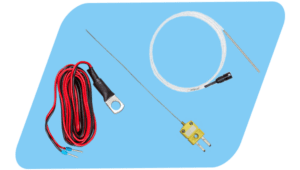Which Temperature Sensor is Best For My Application?
 Temperature is probably the most common parameter measured by our data loggers. Some devices like the TandD TR71A come bundled with general-purpose temperature sensors while other systems such as the dataTaker DT80 Universal Input data logger require the user to provide sensors. Also, some applications like monitoring the temperature of the fluid inside a pipe or tank require specialized temperature sensors to suit the physical requirements of getting the sensor in good thermal contact with what is to be measured. Now, there are quite a number of different kinds of devices that can provide an electrical output proportional to a temperature such as a thermocouple, resistance temperature detector (RTD), thermistors, and so on. Selecting the best sensor for a particular application requires looking at several different criteria and the tradeoffs between the different sensor types.
Temperature is probably the most common parameter measured by our data loggers. Some devices like the TandD TR71A come bundled with general-purpose temperature sensors while other systems such as the dataTaker DT80 Universal Input data logger require the user to provide sensors. Also, some applications like monitoring the temperature of the fluid inside a pipe or tank require specialized temperature sensors to suit the physical requirements of getting the sensor in good thermal contact with what is to be measured. Now, there are quite a number of different kinds of devices that can provide an electrical output proportional to a temperature such as a thermocouple, resistance temperature detector (RTD), thermistors, and so on. Selecting the best sensor for a particular application requires looking at several different criteria and the tradeoffs between the different sensor types.
Basic Sensor Principles
In typical everyday applications, the most common sensor types are thermocouples, RTDs, and thermistors. In evaluating which to use, it is useful to understand how these devices convert temperature into an electrical signal that can be measured by a data logger.
Of all of the different types of temperature sensors, thermocouples are the most common. On the surface, the thermocouple is a very simple device; it consists of wires made from 2 different metal alloy wires that are twisted, welded, or fused together creating what is known as the junction. Thermocouples rely on the fact that whenever you have 2 different conductive materials in electrical contact with one another, a voltage will be created across the point where they are joined and this voltage will change as the temperature between the junction and the end of the wires changes. By closely controlling the composition of the 2 wires the voltage vs. temperature characteristic will follow a very well-defined characteristic defined in ITS-90.
There are 2 very important practical considerations of using thermocouples:
- The voltage that is created is very small, typically in the range of -.01 to +.06 volts
- The voltage is proportional to the difference in temperature between the junction and the ends of wires which requires a second independent temperature measurement at the point where the wires connect to the instrument called the reference junction temperature to derive the actual temperature at the junction.
RTDs operate on an entirely different principle, the change in resistance of a conductor (wire) with the change in temperature. For different types of metals, such as platinum, copper, or nickel, this change called the temperature coefficient of resistance is very consistent. Measurement of temperature with an RTD requires knowing the resistance of the RTD at 0°C, typically 100 ohms, measuring the resistance of the RTD, and then calculating its temperature by knowing the temperature coefficient. For example, a PT100 is a platinum RTD that measures 100 ohms at 0°C with a temperature coefficient of either .00385 ohms/degree (IEC/DIN standard) or .003902 ohms/degree (U.S. Industrial standard).
RTDs have an advantage over thermocouples in that the measurement is absolute, which is to say it does not depend on a second measurement like the thermocouple reference junction temperature. RTDs provide a more accurate measurement than thermocouples as defined by the class of the sensor. However, there are 2 important considerations when choosing RTDs.
First, they have a more limited temperature measurement range than thermocouples. Second, since the resistance is relatively low, typically 100 ohms, the resistance of the lead wires between the sensor and the measuring device can have a significant impact on the accuracy of the measurement. It’s for this reason that RTDs are often configured to use a 3 or 4-wire connection to improve the measurement accuracy.
The third common type of temperature sensor is thermistors which are a specialized type of electrical resistor, often a semiconducting material that has a non-linear relationship between temperature and resistance. Thermistors can have either a positive coefficient (PTC) where the resistance increases with increasing temperature or a negative coefficient (NTC) where the resistance change is in the opposite direction of temperature change – the resistance goes down as the temperature goes up. Whereas the resistance of an RTD might change by 0.3-0.4 ohms/°C the change in resistance of a thermistor can be 100 to 1000x greater, from 30 to > 400 ohms/°C.
Because the change in resistance is non-linear thermistors can have high accuracy but the tradeoff is that they normally have a more limited measurement range than RTD’s or thermocouples. Also, because the change is non-linear, the calculation of the temperature from the measured resistance is more complex although a linear approximation may be used over a limited temperature range.


Leave a Reply
You must be logged in to post a comment.